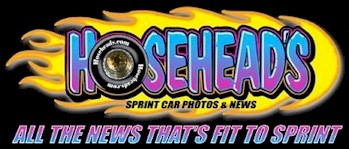|
I'm sure this question applies to most dirt racing in general. It also depends on the nature of the track (size, dirt type, banking, condition/lines of the track at the time). But my inquiry simply concerns the physics and tactical nature of handling a sprint car (winged) at speed.
For instance, if going to ride the cushion (high side) and going full throttle (or close to it) going straight. What does the driver do to navigate the turn (entry.. exit.. Etc). Main question is... Do they always let off the throttle... Flick the wheel.. Then get back into throttle, or tap the brake (with bias to front left) to let the rear end loose.
Reason I ask is two fold. 1.) when watching in car views I notice very little left steering input upon entering the turn prior to turning back right into the slide 2.) I always see the brake rotors glowing, but can never understand at what point they would actually hit the brake (in a lot of cases listening to motor..I never hear the throttle come off completely so are they applying both at same time?
My thoughts would be the fastest route would be as little actual sliding as possible. I remeber watching Stevie Smith in Quali for Knoxville and his tires would go left and right at same pace throughout the whole turn (ie almost no sliding)... Where some drivers slide and wheels are pretty much turned right the majority of the turn.
My assumption is that due to the large stagger a good portion of the actual turning is navigated simply by throttle/brake application.
Would love some experienced/first hand feedback.
|
|
OE Boy, your question is largely dependant on many varibles, (settup) and driver feel, a biggy is track condition and size, its pretty tuff to be vauge on a responce, because there is so many varibles, AND alot of drivers choose to drive differently, the biggy with experinaced drivers flowing thro traffic is they are going places they mildly set up for, and they manipulate the car to achieve passes, the track is consistantly changing erratically or slowly , with 24 cars running a select groove, the path is "slicked off" or "comes in" quickley, sometimes the brakes you see glowing is dependent on how much drag a driver is pressurizing the system with,(like rolling up on a stoplight lightly riding the brake), or using them to get the car to react as they choose ), the brake system on sprinters is pretty simple, not much (if any) drivers us a bias settup such as you see in stockcar racing, they do(some) run a residual valve, that allows a slight amount of pressure to remain on the calipur, and some drivers like the feel of the pedal better that way, (less throw- or travel on the pedal) overheating the brakes can become a problem when glowing for a large duration of a race, a driver can experiance brake fade if he (kills) the breaks to achive his selected position, the temprature of the fuild can become almost boiling, we dont use simple DOT brake fuild, ours is high temp, and very specific fluid, if the loss of brake pedal feel starts to fade, a driver can be in trouble because he has to change his driving, alot of your "Heavier" (sticky) track conditions you will find drivers "breath" the throttle on entry, its pretty tuff to hear by the human ear, a tachometer reading or (telemetry for enthusiests) if it were aval would show you the slight lift, and sometimes, there isnt any lift at all, the use of the brakes generally is less on heavier tracks, again it just depends on what the driver is feeling, larger tracks you will see the drivers have less steering input, the car is strait for a longer duration, and traveling a greater speeds, "wingSpeed" is a big word in the winged sprintcar world because it effects the car differently due to track size, and loads the car traction wise alot more on 1/2 miles vs 1/4 miles, LASTLY, tires, a driver sliding the car alot, again depending on track conditions, may use up his grip premature, the good drivers will know when to make the most of his tires, late or earlie in a race, almost 70% of the time, the tires are shot at the race end,, wether it be late in the race or earlie the driver will "use up" his grip to the track, cars coming on late typically have alot more rubber under them vs the cars you see slow-fade a tish at the closing laps, drivers with great fast laps earlie in a race it is entertaining to see them "hold on" to that pace the entire race, thier fuel load is changing, thier tires are either coming to them or going away, the track is changing, its alot to negotiate in a small period of time, sprint racing takes some premeditation of the crew,tire prep,and saving the tires by design of the driver, there is alot of feel from the driver, no feedback to the crew untill the race is complete, (unless open red) or simple hand signals to the crew, sprint racing takes alot of settup stradegy in a "one shot" type race, drivers need to know when his time is right to make the most positions and ole lady luck never hurts.. unlike stock car racing the outcome will be over shortly, alot will be happening in the next 25-35 laps, there isnt alot of Lucky dogs or second chances in sprint racing which makes it so exciting, I hope that helps a little, there is sooo much more to explain in detail to your questions, but, in a nutshell, thats it.... enjoy!
|
